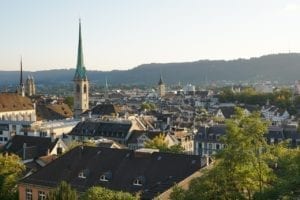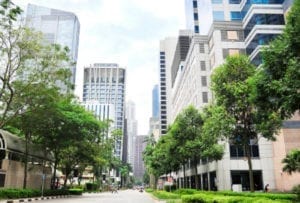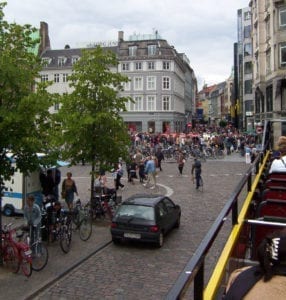Sustainability… Perhaps one of the most overused buzzwords of the 21st Century. But what does it actually mean, and why is it so critical? More importantly, what cities are doing it right and making a real impact on not only regional, but global sustainability? This article looks into these points and discusses how green infrastructure plays a role in sustainability. We’ll also detail the world’s top ten most sustainability cities and talk about some of the ways they achieved their ranking.
Sustainability is about the balance of meeting present society’s needs without compromising the ability of future generations to meet their own needs. This is an important consideration when municipalities and professional practices, such as landscape architecture and civil engineering, design and shape our cities.
Today, only the elderly can remember the appalling air pollution that faced cities around the world, and that largely precipitated a major shift in attitude to environmental health. For example, the “London smogs” were proven to have caused many immediate and delayed fatalities through respiratory and cardiac disease.
On December 4th 1952, an anticyclone settled over London. The wind dropped and the air grew damp. The great London smog lasted five days blanketing the city. In leafy West London suburbs, bus conductors walked in front of their buses with burning rolled up newspapers because the drivers could not see the kerb from their cabs. Around four thousand deaths were directly attributable to it. Unchecked pollution from nineteenth century urbanization and the industrial revolution had created unsustainable conditions incompatible with human lifestyle.
It was time for a new approach to urban sustainability. Governments could no longer ignore these increasingly worrying events, with the first Clean Air Act being introduced in 1956. This Act aimed to control domestic smoke pollution by introducing zones where only smokeless fuels could be burnt, in addition to helping reduce sulphur dioxide levels.
The sustainability of cities is now assessed on much wider criteria than aerial pollution alone. Quality of life, including health, education and even work/life balance join the economic considerations such as ease of doing business and GDP per capita.

Sustainability is a hot topic for cities across the globe. The UN’s Sustainable Development Goal 11, focusing on sustainable cities and communities disqualifies attempts to regard it as optional. The World Economic Forum’s ‘Inspiring Future Cities & Urban Services’ report highlights the challenges posed by urbanization. Their report suggests that current patterns are still unsustainable, but does however, offers solutions demonstrating that urbanization, when properly managed, can be a powerful and transformative process.
Overall sustainability rankings according to the Sustainable Cities Index published in 2016, make an interesting study.
Top 10 – Overall Ranking
- Zurich
- Singapore
- Stockholm
- Vienna
- London
- Frankfurt
- Seoul
- Hamburg
- Prague
- Munich
Bottom 10 – Overall Ranking
- Bengaluru
- Mumbai
- Chengdu
- Wuhan
- Cape Town
- Manila
- New Delhi
- Nairobi
- Cairo
- Kolkata
Merely creating public realm by allocating space to pedestrian or other civic amenities is no longer sufficient to improve metropolitan sustainability ratings. Environmental considerations have become a much larger factor in sustainability – both sociologically and economically.
Biophilia is a term popularized by Harvard University myrmecologist and conservationist E.O. Wilson over the past quarter century describing the extent to which humans are hard-wired to need connection with nature and other forms of life.
For the past twenty-five years, GreenBlue Urban has been at the forefront of the research and development of horticultural and engineering solutions. It is consequently recognized both as a consultancy and supplier of adaptable and cost effective products in both Europe and North America.
Replacing life threatening, arid, sub-pavement conditions with uncompacted root-space, drainage, irrigation and aeration systems to encourage sustainable life has led, through academic research in universities and by industry professionals, to the development of highly effective engineered solutions to the challenges of urban renewal.
Today, the greening of the urban environment is recognized as a major contributor to regeneration projects to improve the sustainability ratings of concerned cities. Support for the practice of biophilic design is growing. Many buildings now integrate natural features and qualities. Urban residents and workers increasingly expect access to a more natural ambience, especially in public realm schemes.
It is these environmental factors that constitute the more specific urban sustainability ratings based on ‘Planet Factors’. These are significantly different to the ‘overall ratings’ which take into account many sustainability factors, not just environmental.
Top 10 – Environmental Ranking
- Zurich
- Stockholm
- Geneva
- Vienna
- Frankfurt
- Wellington
- Rome
- Sydney
- London
- Hamburg
Bottom 10 – Environmental Ranking
- Shanghai
- Chengdu
- Cairo
- Lima
- Abu Dhabi
- Dubai
- Beijing
- Doha
- Wuhan
- Kolkata

Both tables credit Zurich with being the most sustainable city in the world. Zurich has a strong reputation as a liveable, contemporary city known for its strong focus on environmentalism. Public transit in the city is also highly regarded as a sustainable model for other cities. Trams, trains, buses, light rail, and more are highly coordinated, making mobility simple, quick and affordable. Doubtless, the other cities featuring as top sustainable cities in both charts would feature in any list of green cities of the world.
As one of the only Asian cities to make it amongst the top ten, Singapore claims the space as Asia’s most sustainable city based on three specific strategies. First, water management – the reuse of reclaimed water, rainwater catchment systems, and saltwater desalination. Second, Singapore’s government built effective public transportation systems and established regulations that discourage casual or unnecessary car ownership. Most Singaporeans walk, bike, or use public transportation to navigate the city. Thirdly, ‘Green’ Planning – extending to the hosting of the ‘World Cities Summit’ the international forum for urban sustainability thinking and debate.

Copenhagen is a city by the sea with water running through the old canals, with lakes, beaches and harbour baths – no surprise that it ranks high in sustainability assessments. Long known for its addiction to clean healthy cycling, Copenhagen’s most ambitious urban planning project so far is the development of a new district in the city’s northern harbour, Nordhavn, which is the largest urban development project in Northern Europe. State-of-the-art knowledge from all over the world will contribute to Nordhavn becoming the sustainable city of tomorrow.

In both Copenhagen and Singapore, GreenBlue Urban systems have been used to ensure the proper planting of urban trees so that healthy, mature trees can be counted on to provide their numerous benefits, and support towards the overall sustainability achievement.
To the functional benefits provided by trees, green roofs, wetlands such as managing stormwater, mitigating air and water pollution, and addressing urban heat island effects, less tangible considerations have become essential. Cities enriched with thriving green spaces and urban afforestation draw job seekers and retail footfall. Rising GDP per capita fuels capital gains on top of the improved perception of well-being and overall attractiveness of the environment.
Although geographic factors such as location, climate, and access to resources make comparing cities difficult, reviewing which urban centers are achieving higher levels of sustainability, and more importantly why, gives cities the opportunity to measure their own overarching performance, to benchmark and learn from higher placed cities and take action to improve future performance.


